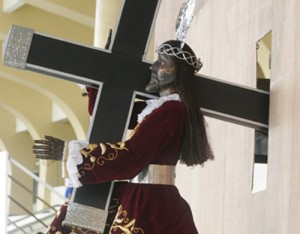THE Manila City Council has declared January 9, the Feast of the Black Nazarene, a special non-working holiday in the city.
A resolution passed on first reading by the council said the feast would highlight the “religious significance and cultural importance of the Feast of the Black Nazarene” and that there is truly a need to “preserve, enshrine, and promote its observance, commemoration, and celebration in the City of Manila.”
The city had earlier announced the suspension of classes on Thursday to spare students from being stranded because of the expected deluge of devotees.
“It is essentially sound for Manila to propose a local holiday on the Feast of Black Nazarene,” according to Councilor DJ Bagatsing who authored the ordinance.
“This would give loyal worshippers a better chance of engaging in this sacred tradition,” he said.
The Light Rail Transit Authority (LRTA) meantime said barefoot devotees will again be allowed in trains.
LRTA spokesman Hernando Cabrera said in a radio interview that LRT rides will not be free and security inspections will continue. He said the number of LRT commuters doubles during the Feast of the Black Nazarene.
Last year, on January 9, the LRTA had a record number of 612,371 passengers.
Since the procession will not pass through the usual route, McArthur Bridge, which the Department of Public Works and Highways said is only fit to handle 20 tons or 10,000 people at any given time, the procession is expected to last 10 to 12 hours.
Traffic rerouting is being worked out by the Metro Manila Development Authority, the City of Manila and Manila Police District.
As of Tuesday morning, traffic policemen and personnel from the Manila Traffic and Parking Bureau were seen manning the Quiapo boulevard, which was filled with hawkers peddling statues, T-shirts, scapulars and other religious images including amulets believed to protect people from harm and illnesses.
Msgr. Clemente Ignacio, parish priest of Quiapo church, home of the Black Nazarene, said that the Traslacion will stop for a while at the San Sebastian Church to pay respect to the Virgin Mary.
Fr. Ignacio asked the devotees to give more importance to the spiritual aspect of the Traslacion. He clarified that the feast of the Black Nazarene is not confined to the procession but to masses, novenas and other religious practices.
The traditional “pahalik” of the Black Nazarene had already started after the venerated image was transferred to Quirino Grandstand Monday evening.
In another development, retired Lingayen-Dagupan Archbishop Oscar Cruz criticized Manila city officials for their plan to make the annual feast of the Black Nazarene an international pilgrimage in a bid to attract more tourists.
Cruz lamented that the city is promoting the feast of the Nazarene as a business opportunity, a big insult to the millions of devotees.


